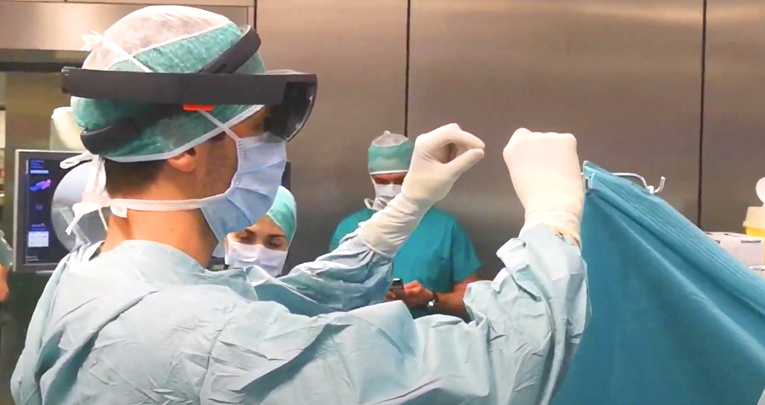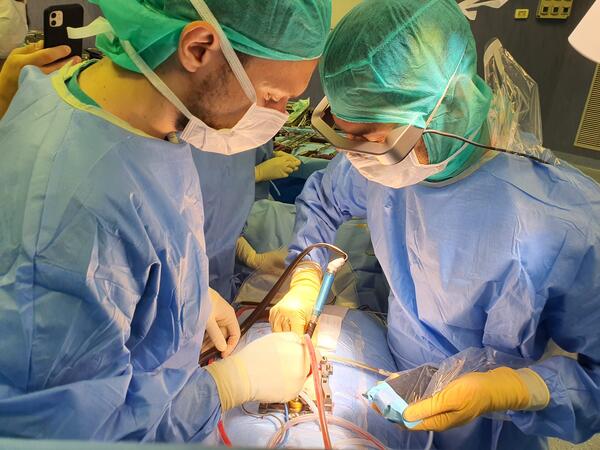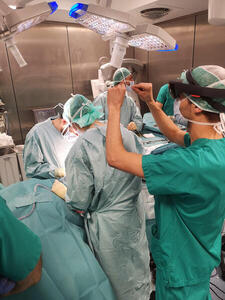
Frontiers in Surgery , 30 March 2021
Augmented Reality in Medical Practice: From Spine Surgery to Remote Assistance
Fabio Cofano 1,2 , Giuseppe Di Perna 1 , Marco Bozzaro 2 , Alessandro Longo 3 , Nicola Marengo 1 , Francesco Zenga 1 , Nicola Zullo 4 , Matteo Cavalieri 5 , Luca Damiani 5,6 , Daniya J. Boges 5,7 , Marco Agus 8 , Diego Garbossa 1 and Corrado Calì 9,10 *
Background
While performing surgeries in the OR, surgeons and assistants often need to access several information regarding surgical planning and/or procedures related to the surgery itself, or the accessory equipment to perform certain operations. The accessibility of this information often relies on the physical presence of technical and medical specialists in the OR, which is increasingly difficult due to the number of limitations imposed by the COVID emergency to avoid overcrowded environments or external personnel. Here, we analyze several scenarios where we equipped OR personnel with augmented reality (AR) glasses, allowing a remote specialist to guide OR operations through voice and
ad-hoc
visuals, superimposed to the field of view of the operator wearing them.
Methods
This study is a preliminary case series of prospective collected data about the use of AR-assistance in spine surgery from January to July 2020. The technology has been used on a cohort of 12 patients affected by degenerative lumbar spine disease with lumbar sciatica co-morbidities. Surgeons and OR specialists were equipped with AR devices, customized with P2P videoconference commercial apps, or customized holographic apps. The devices were tested during surgeries for lumbar arthrodesis in a multicenter experience involving author's Institutions.
Findings
A total number of 12 lumbar arthrodesis have been performed while using the described AR technology, with application spanning from telementoring (3), teaching (2), surgical planning superimposition and interaction with the hologram using a custom application for Microsoft hololens (1). Surgeons wearing the AR goggles reported a positive feedback as for the ergonomy, wearability and comfort during the procedure; being able to visualize a 3D reconstruction during surgery was perceived as a straightforward benefit, allowing to speed-up procedures, thus limiting post-operational complications. The possibility of remotely interacting with a specialist on the glasses was a potent added value during COVID emergency, due to limited access of non-resident personnel in the OR.
Interpretation
By allowing surgeons to overlay digital medical content on actual surroundings, augmented reality surgery can be exploited easily in multiple scenarios by adapting commercially available or custom-made apps to several use cases. The possibility to observe directly the operatory theater through the eyes of the surgeon might be a game-changer, giving the chance to unexperienced surgeons to be virtually at the site of the operation, or allowing a remote experienced operator to guide wisely the unexperienced surgeon during a procedure.
Graphical representation of AR information flow between OR and remote users.
Left: Neurosurgeon operatiing wearing BT-300 AR goggles. Top panel: key personnel in the OR (i.e., physician, technicalspecialists, surgeons) wearing AR goggles equipped with software for digital content superimposition (Unity custom tool) and/or video streaming and interaction (e.g., TeamviewerPilot) from the OR. Goggles models from the right: Microsoft Hololens, Vuzix Blade, Epson BT-350, Epson BT-300.
Bottom panel: personnel outside the OR can visualize the video streaming from goggles equipped with Teamviewer Pilot via TeamViewerapp on laptops, tablets or smartphones.
1
Neurosurgery Unit, Department of Neuroscience “Rita Levi Montalcini,” University of Torino, Turin, Italy
2
Spine Surgery Unit, Humanitas Gradenigo, Turin, Italy
3
Spine Surgery Unit, Humanitas Cellini, Turin, Italy
4
Spine Surgery Unit, Casa di Cura Città di Bra, Bra, Italy
5
Intravides SRL, Palazzo degli Istituti Anatomici, Turin, Italy
6
LD Consulting, Chiavari, Italy
7
BESE Division, King Abdullah University of Science and Technology, Thuwal, Saudi Arabia
8
College of Science and Engineering, Hamad Bin Khalifa University, Doha, Qatar
9
Neuroscience Institute Cavalieri Ottolenghi, Orbassano, Italy
10
Department of Neuroscience “Rita Levi Montalcini,” University of Torino, Turin, Italy










